Nebraska is home to numerous incredible geographic landscapes, including the Loess Canyons, the Nebraska Sandhills, the salt marshes of Salt Creek, the Wildcat Hills, and the Pine Ridge Escarpment, among so much more.
With so many incredible landscapes, the state is home to pretty amazing wildlife and birdlife, too. More than 400 species of birds live in Nebraska for at least part of the year, which is pretty incredible!
We recently published a Bird Guide to Nebraska, which overviews some of the incredible birds of prey, hummingbirds, corvids, songbirds, and more that live in the state.
Of those 400 birds, there are 25 kinds of sparrows who find their way to Nebraska every year or who are year-round residents. Sparrows are cute little birds with big personalities and lots of variation from species to species.
What Makes a Sparrow a Sparrow?
Sparrows are sometimes called “little brown jobs,” as they are usually quite small, brown, and drab. Even so, there are some noticeable differences from one species to the next when you start to pay attention.
Sparrows tend to be very small birds with sharp, conical bills. They tend to live or at least nest in shrubs and thickets, although some nest in barn rafters and others right on the edge of the ocean.
They can be migratory or non-migratory. Some are solitary whereas others are incredibly social and gather in groups that number in the thousands.
Finally, sparrows are usually some shade of brown, often with dark streaks on their backs and wings, and may have flashes of yellow, black, white, or gray.
How Many Sparrows Are in Nebraska?
In our list, we have only included sparrows that are routinely found in the state. We’ve included birds that are here for the summer only, the winter only, during migration only, or present all year long, but we have not included exceptionally rare vagrants who may have accidentally ended up here once or twice.
We have divided the list into groups based on when these sparrows are in Nebraska. That way, you can pay attention to when you saw a bird on this list in order to help identify it!
What To Pay Attention to When Learning to ID Sparrows
Full disclosure: identifying sparrows can be a challenge! Even experienced bird watchers are likely to struggle with some of the sparrows on this list.
But this actually makes spotting and identifying sparrows a pretty fun challenge!
When you see an unfamiliar sparrow, take note of the following to help with identification:
- Coloring
- Shape
- General appearance
- What it is eating
- Where it was seen (specific habitat and region)
- When it was seen (time of year, time of day)
- Vocalizations
With this information at hand, let’s get into this list!
The One Sparrow That Lives in Nebraska Year-Round
There is actually only one kind of sparrow that lives in Nebraska all year: the House Sparrow.
House Sparrow
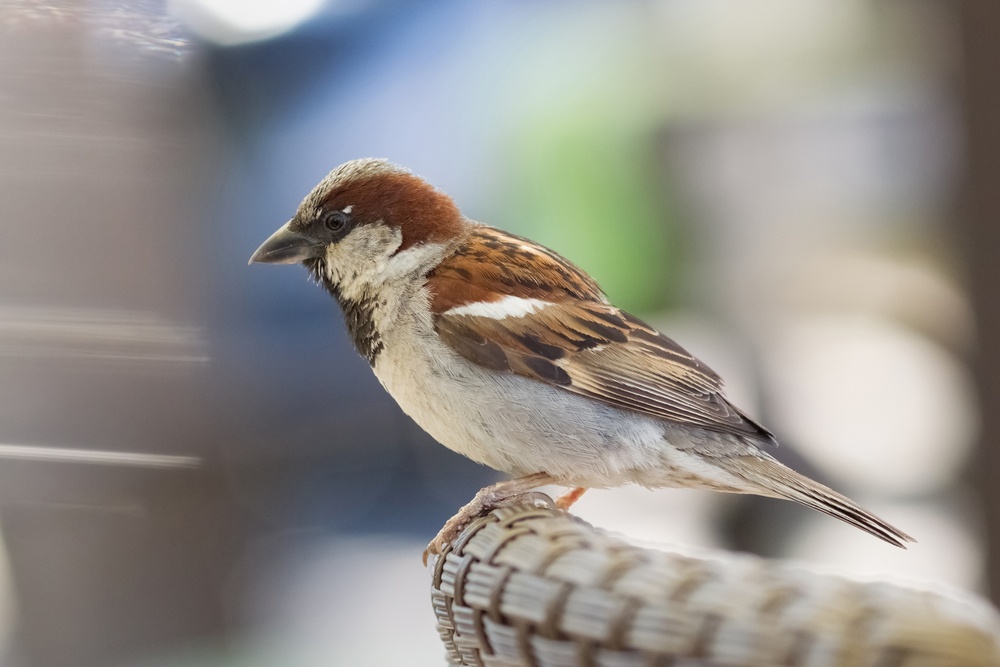
- Passer domesticus
- ORDER: Passeriformes
- FAMILY: Passeridae
- Length: 5.9-6.7 in (15-17 cm)
- Weight: 0.9-1.1 oz (27-30 g)
- Wingspan: 7.5-9.8 in (19-25 cm)
House Sparrows are likely North America’s most aggressive sparrow. They get their name from the fact that they nest in houses, barns, and buildings. They are tenacious little sparrows who thrive in urban areas and easily outcompete native species.
They are widespread throughout Nebraska, but you won’t find them in forests or fields. Instead, you will find them in cities, and towns, and living right next to buildings in more isolated areas.
Males are gray-headed with white cheeks, black bibs, and rufous necks. Females are brown and stripy.
Sparrows That Live in Nebraska Only in the Summer
In addition to the House Sparrow that is here year-round, there are a lot of sparrows that are only here in the summer. These birds often arrive in early spring (between March and May) and leave again in the fall. They may have a different appearance in the breeding season than they do in the winter.
These summer sparrows are the Cassin’s Sparrow, the Chipping Sparrow, the Eastern Towhee, the Field Sparrow, the Grasshopper Sparrow, the Henslow’s Sparrow, the Lark Bunting, the Lark Sparrow, the Spotted Towhee, and the Vesper Sparrow.
Cassin’s Sparrow
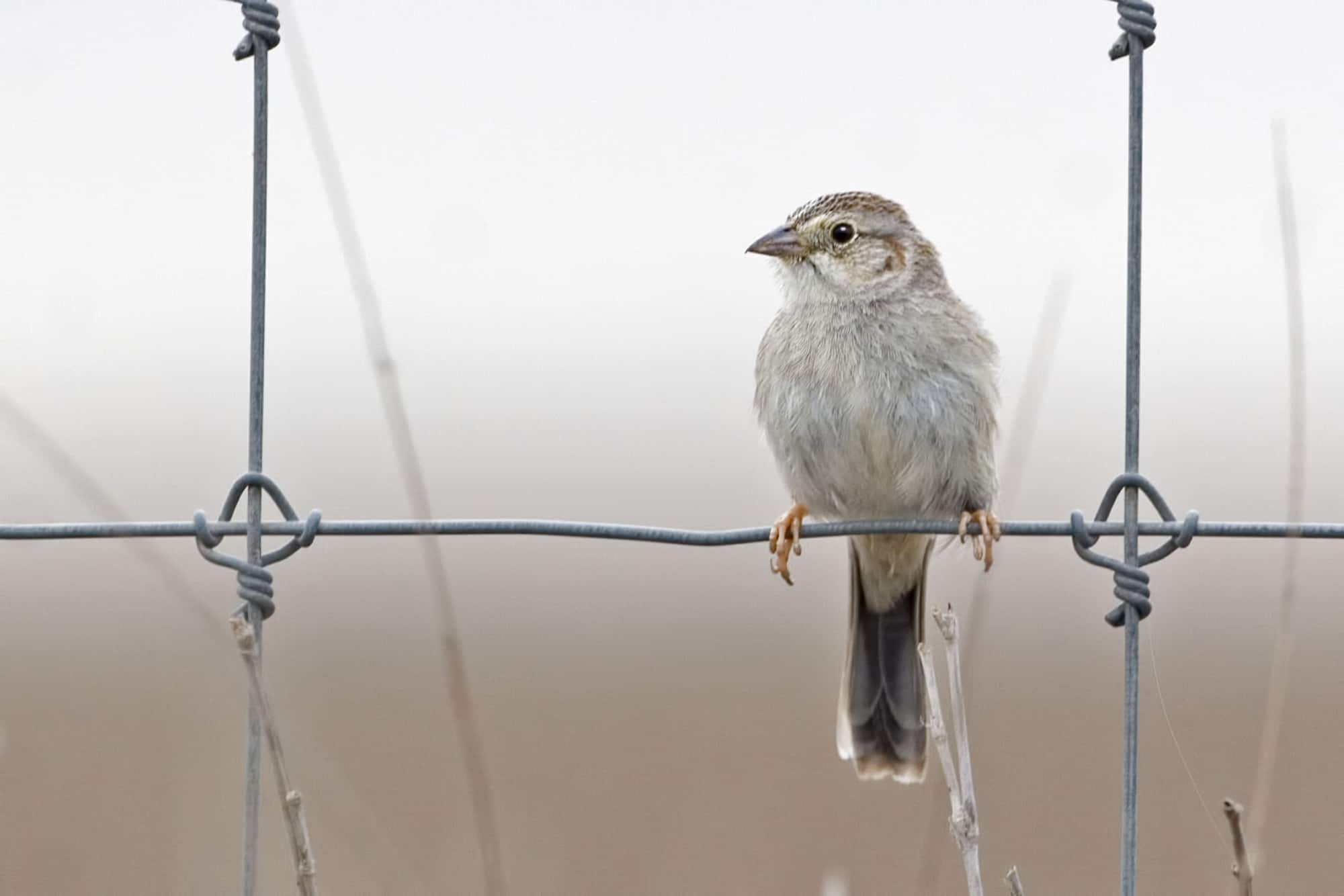
- Peucaea cassinii
- ORDER: Passeriformes
- FAMILY: Passerellidae
- Length: 5.1-5.9 in (13-15 cm)
- Weight: 0.6-0.7 oz (16-21 g)
- Wingspan: 7.9 in (20 cm)
Cassin’s Sparrows are grayish-brown with minimal markings. They have some dark streaking on their flanks and a very light eyering that is barely noticeable.
They have a longer tail than many other sparrows, and their bill is longer than the average sparrow’s bill, too. In general, they are just bigger sparrows than other species.
Their chosen habitat includes dry, shrubby grasslands, often with cacti, small trees, and yucca. They don’t spend time in especially thick brush, preferring to be somewhat out in the open. There is not a significant change in their habitat preferences between breeding and non-breeding seasons.
They nest in Nebraska’s grassy hills in the west, with a breeding range that only includes a few Great Plains and Southwestern states, as well as Mexico.
Chipping Sparrow
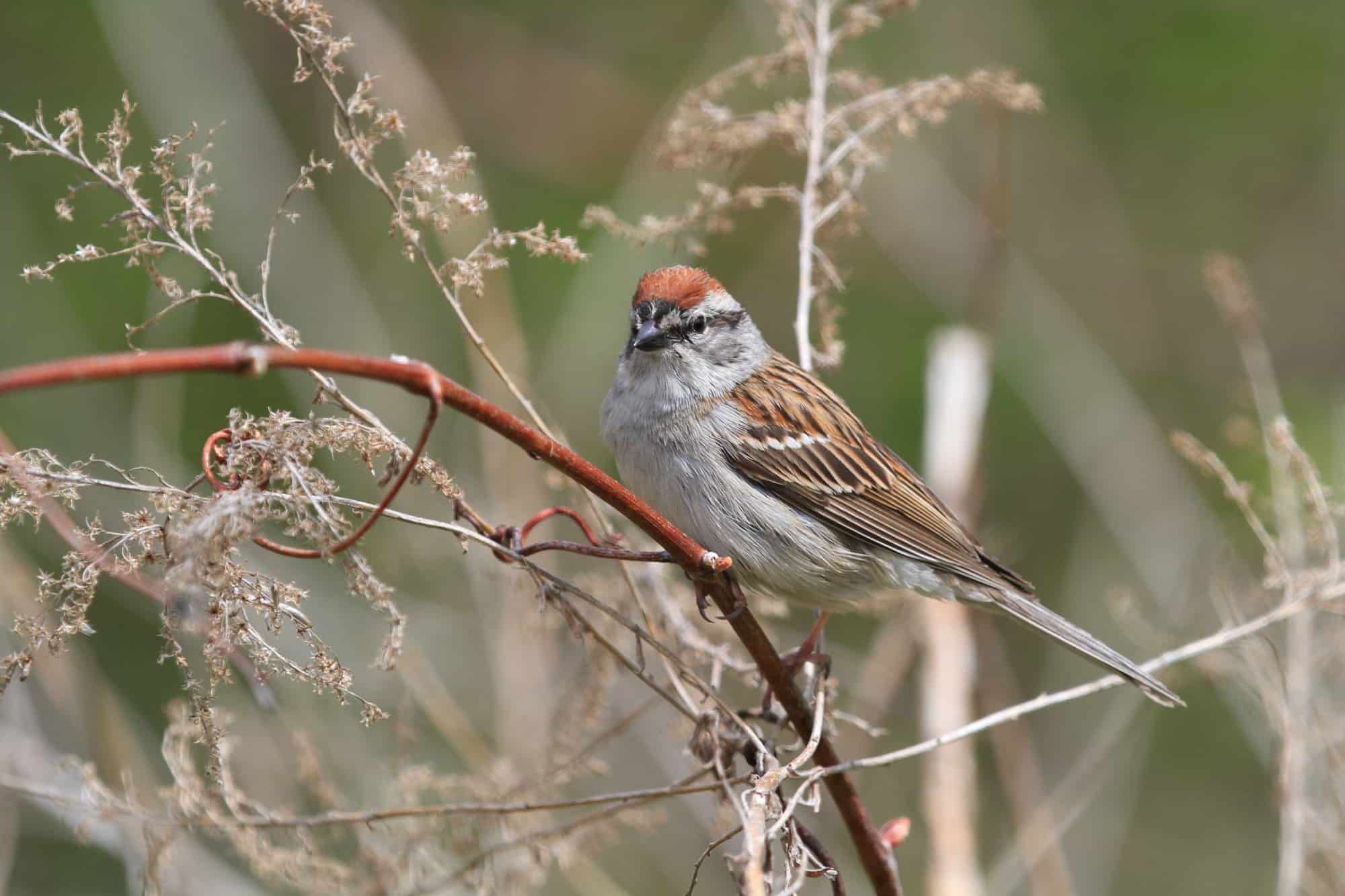
- Spizella passerina
- ORDER: Passeriformes
- FAMILY: Passerellidae
- Length: 4.7-5.9 in (12-15 cm)
- Weight: 0.4-0.6 oz (11-16 g
- Wingspan: 8.3 in (21 cm)
Chipping Sparrows are incredibly widespread North American sparrows. They spend the summer in almost every US state and most of Canada.
Male Chipping Sparrows are streaked with dark coloring on their wings and backs. They have a rufous cap. Females are darker but with similar patterns.
They are great for pest control, as they consume large amounts of insects in the summer. They eat leafhoppers, caterpillars, beetles, spiders, crickets, grasshoppers, and more.
They prefer to nest in grassy areas, such as Nebraska’s open prairie grasslands. They build an open cup-shaped nest from weeds, stems, leaves, and roots.
Eastern Towhee

- Pipilo erythrophthalmus
- ORDER: Passeriformes
- FAMILY: Passerellidae
- Length: 6.8-8.2 in (17.3-20.8 cm)
- Weight: 1.1-1.8 oz (32-52 g)
- Wingspan: 7.9-11.0 in (20-28 cm)
Eastern Towhees are very easy to identify! Males are dark from above with a black head, back, and neck. Their bellies are white, and their sides are rufous.
Females, on the other hand, are brown wherever the males are black.
Their “chewink” sound can be heard during the summer when they are breeding residents of eastern Nebraska. They build their cup-shaped nests on the ground or in honeysuckle, greenbrier, and grape bushes. They will sometimes nest up to four feet above the ground.
You will find them in Nebraska’s shrubby fields and wooded areas, especially if there is a lot of ground cover for them to hide in.
Field Sparrow
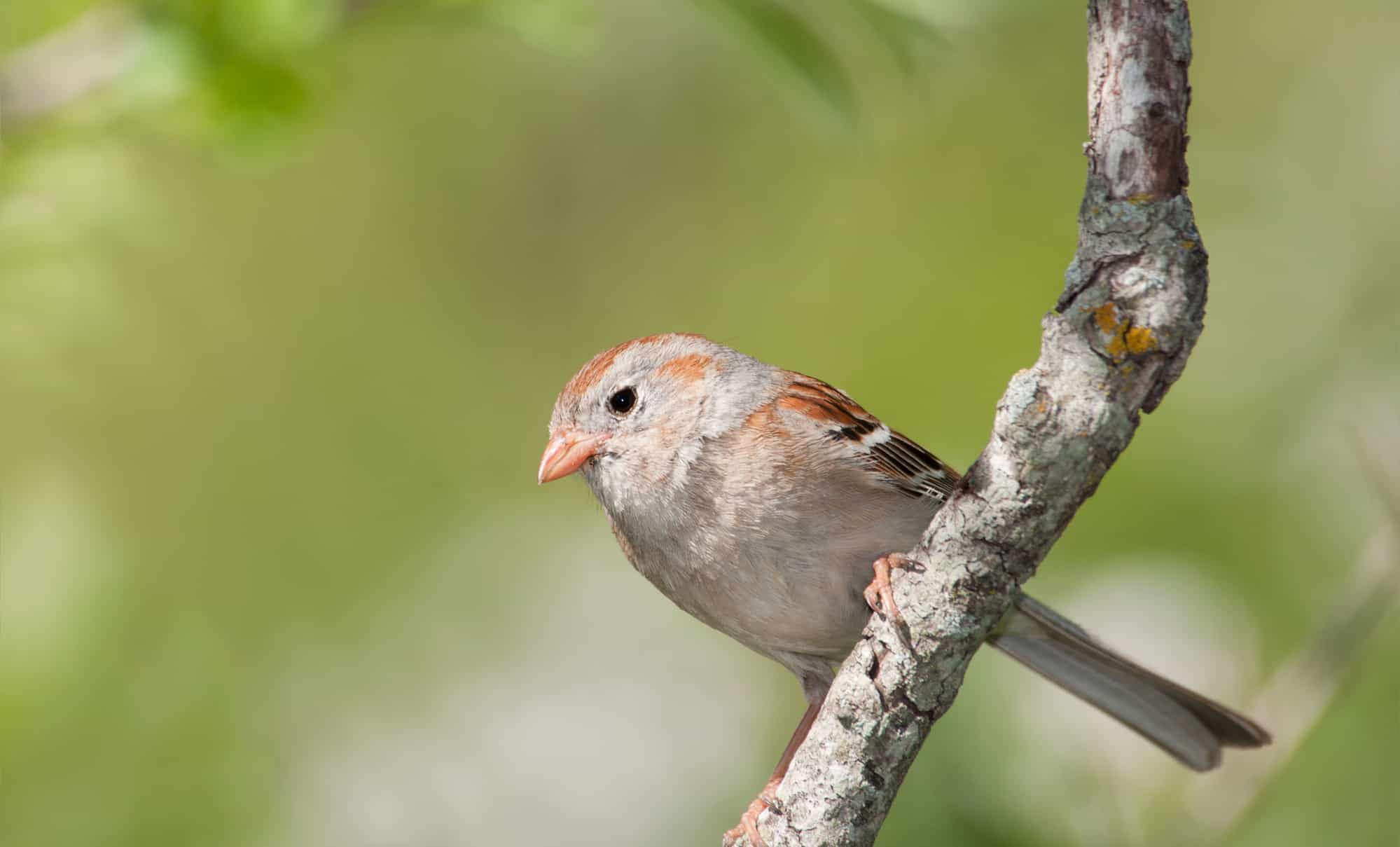
- Spizella pusilla
- ORDER: Passeriformes
- FAMILY: Passerellidae
- Length: 4.7-5.9 in (12-15 cm)
- Weight: 0.4-0.5 oz (11-15 g)
- Wingspan: 7.9 in (20 cm)
The Field Sparrow is sexually monomorphic, which means males and females look generally alike. They are gray-bodied with brown streaks, and they also have pink bills, white eyerings, and a rusty-brown cap on their heads.
They tend to avoid people and instead live in open, grassy areas. Nebraska has plenty of the Field Sparrow’s preferred habitat! That said, overall, Field Sparrows are declining in population due to widespread suburban expansion.
They build their nests on the ground, but sometimes, if their first nest is destroyed by predators, they will build a second one just a bit higher in a bush or small tree.
Grasshopper Sparrow
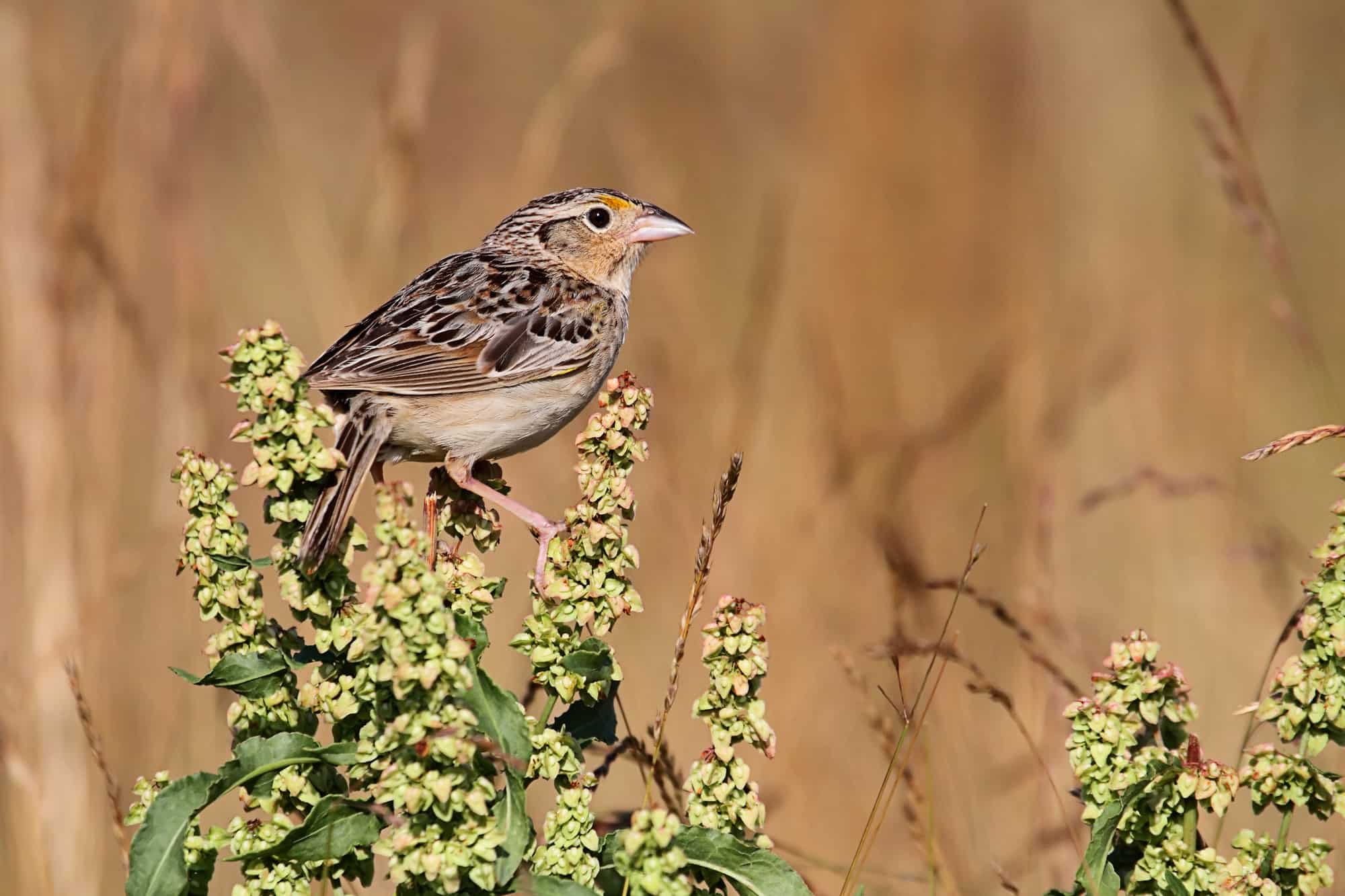
- Ammodramus savannarum
- ORDER: Passeriformes
- FAMILY: Passerellidae
- Length: 4.3-4.5 in (10.8-11.5 cm)
- Weight: 0.5-0.7 oz (14-20 g)
- Wingspan: 7.9 in (20 cm)
Grasshopper Sparrows are plain in their appearance, with some color variation from bird to bird. They can be tan, gray, or even light orange.
Their name comes from the insect-like buzzy notes of the song they make, which is reminiscent of a grasshopper’s noises when it vibrates. Males also sing a squeaky but melodic song, which means that Grasshopper Sparrows are one of the only kinds of sparrows with two different songs.
Grasshopper Sparrows eat grasshoppers and other insects during the breeding season. They are summer residents of Nebraska and are found throughout the state. There is plenty of great habitat for these birds in Nebraska, as they prefer grassy meadows without a lot of shrubs or ground cover.
They are usually on the ground, as they are not very great at flying. That said, they do migrate south in the fall.
You may find a Grasshopper Sparrow perched on a fence post or barbed wire fence line.
Henslow’s Sparrow
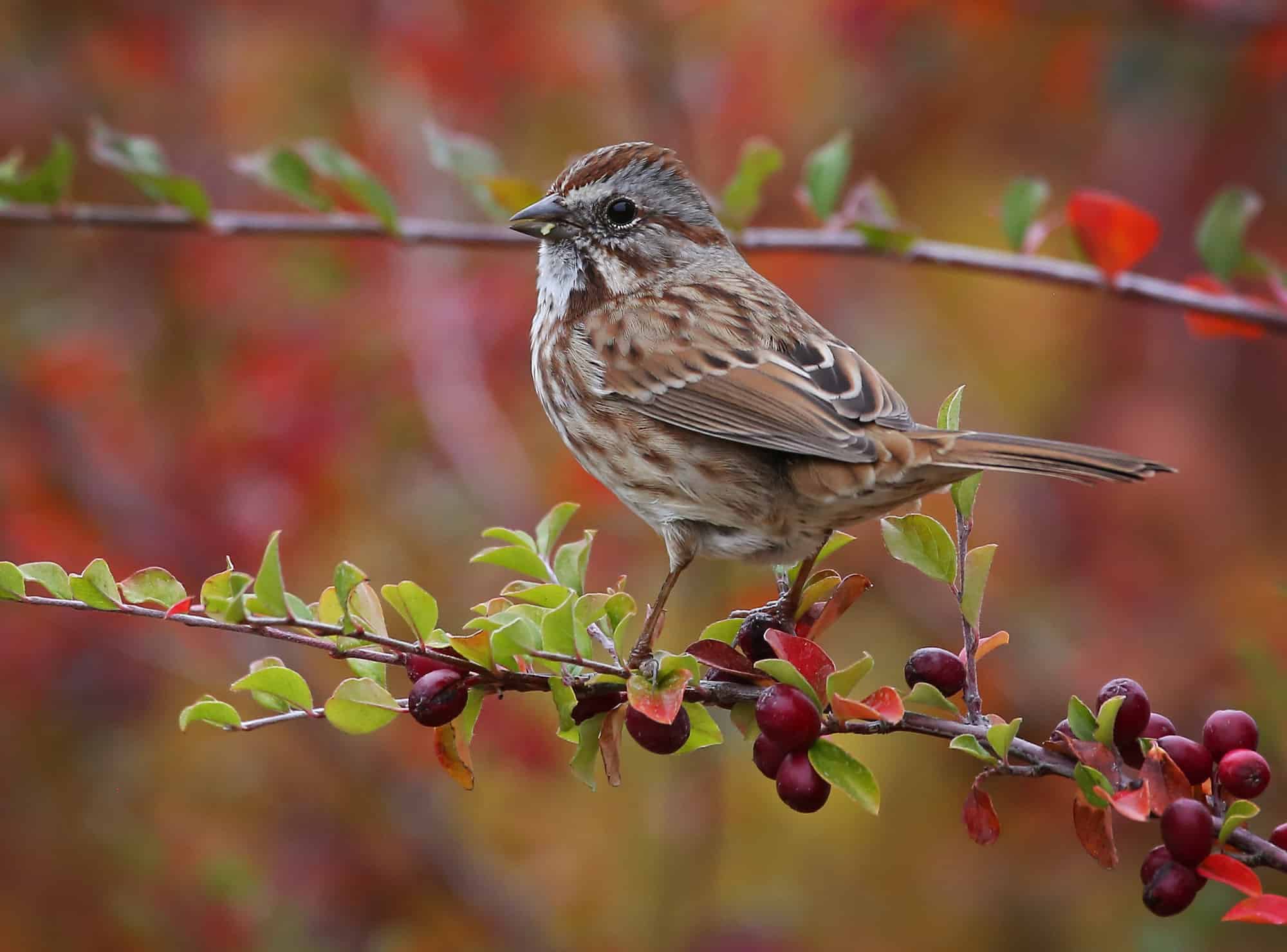
- Centronyx henslowii
- ORDER: Passeriformes
- FAMILY: Passerellidae
- Length: 4.7-5.9 in (12-15 cm)
- Weight: 0.4-0.6 oz (11-16 g)
- Wingspan: 8.3 in (21 cm)
Henslow’s Sparrows are plain-looking. They are mostly buff with some pale green coloring. They have stark black stripes on their backs and wings.
Henslow’s Sparrows are ground nesters who stay hidden from predators by covering their nests with tall, dense grass.
They eat bugs and insects all summer long, including stink bugs, caterpillars, crickets, beetles, and grasshoppers. Their habit of eating wasps should make them a celebrated little sparrow! When they migrate to their winter territory, their diet changes to consist mostly of seeds.
Nebraska is at the far western edge of the breeding range of Henslow’s Sparrows. In fact, they are really only found in Pioneer Country on the eastern border of the state.
Lark Bunting
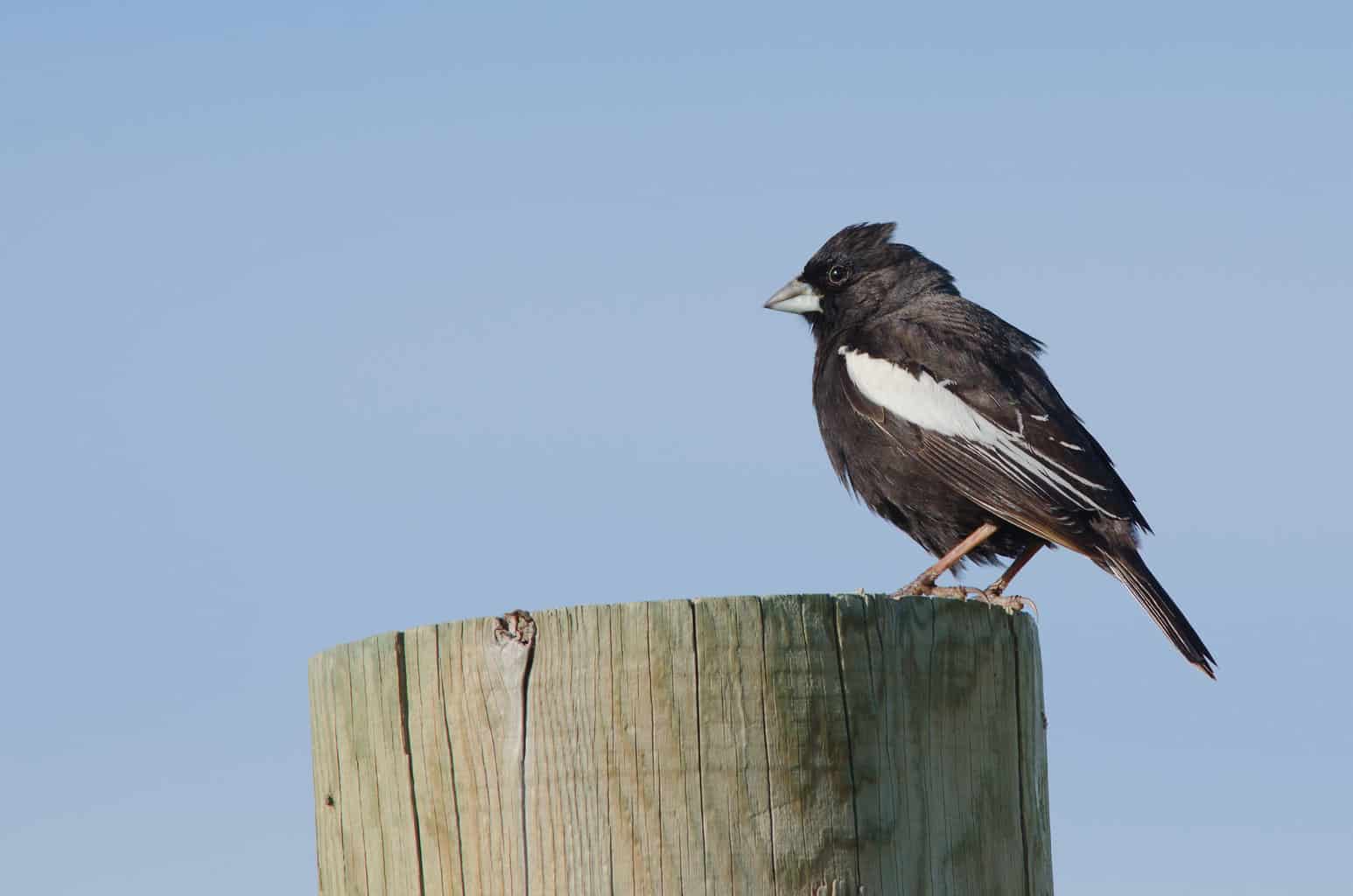
- Calamospiza melanocorys
- ORDER: Passeriformes
- FAMILY: Passerellidae
- Length: 5.5-7.1 in (14-18 cm)
- Weight: 1.3-1.5 oz (35.3-41.3 g)
- Wingspan: 9.8-11.0 in (25-28 cm)
The male Lark Bunting is one of the easiest-to-identify birds on this list – during the breeding season, anyway. Females and non-breeding males are harder to distinguish from other Passeriformes
Breeding-season males are mostly dark black, but they have distinctive white patches on their wings. During the winter, though, their coloring shifts to streaky brown and gray. They still have a lot of white on their upper wings, though. Females, on the other hand, are always streaky gray and brown.
All Lark Buntings have a thick, blue-gray bill.
You won’t see them in Omaha or the surrounding areas, but they do breed in the western three-quarters of Nebraska.
Look for them in shrubby prairies, rather than pure grassland. That’s because they prefer to nest at the base of a shrub or cactus, and these don’t always grow in vast, open prairie land.
Lark Sparrow
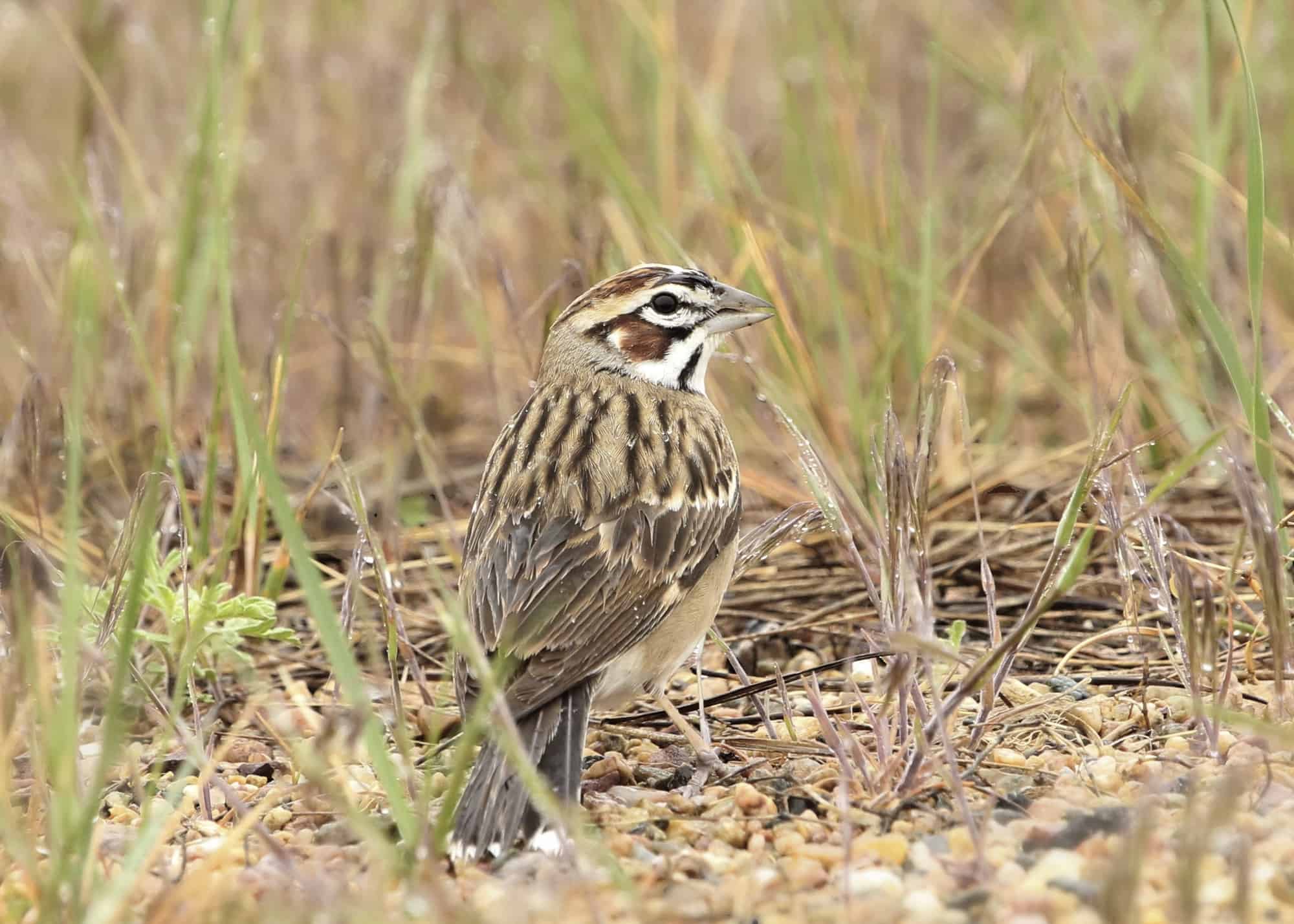
- Chondestes grammacus
- ORDER: Passeriformes
- FAMILY: Passerellidae
- Length: 5.9-6.7 in (15-17 cm)
- Weight: 0.8-1.2 oz (24-33 g)
- Wingspan: 11.0 in (28 cm)
Lark Sparrows have distinctive facial markings: dark brown stripes and a black mustache. Their bodies are light gray, and they have more brown coloration on their wings. The fastest way to identify them is probably the black patch in the middle of their chest.
Lark Sparrows are ground foragers who spend some time in the trees, especially after they have been frightened away by a predator or assumed threat.
They are breeding-season residents of Nebraska and are spread throughout the state. They prefer to nest in an area that is relatively wide-open, although there can be tall plants scattered around. They also like dry grass, shrubby fields, and overgrazed pastures.
Spotted Towhee
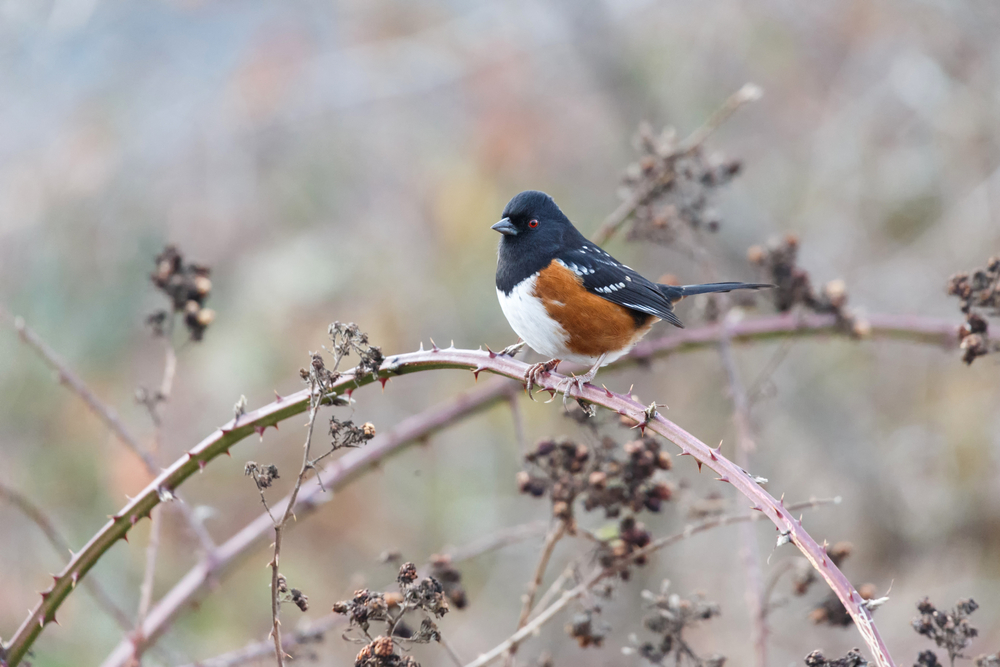
- Pipilo maculatus
- ORDER: Passeriformes
- FAMILY: Passerellidae
- Length: 6.7-8.3 in (17-21 cm)
- Weight: 1.2-1.7 oz (33-49 g)
- Wingspan: 11.0 in (28 cm)
Towhees are significantly different in appearance from other Passeriformes. Spotted Towhees look a lot like Eastern Towhees but with one major difference: Spotted Towhees have white spots all over their back and wings, and Eastern Towhees don’t.
Spotted Towhees are darkly pigmented, with a dark black head, neck, and back. Their sides are rufous, and their belly is white.
Females have the same color pattern, but they are grayish-brown in the places where the males are black.
Most of Nebraska will never see Spotted Towhees, but they do breed in a very small strip of territory in the area between Sidney and Bridgeport, in the panhandle.
They are usually found in thick, shrubby undergrowth, as they avoid open areas. They eat insects during the summer and switch to a mostly plant-based diet in the winter. In the summer, they eat grasshoppers, caterpillars, ants, weevils, beetles, and spiders. In winter, they eat everything from berries and oats to poison oak and sumac.
Vesper Sparrow
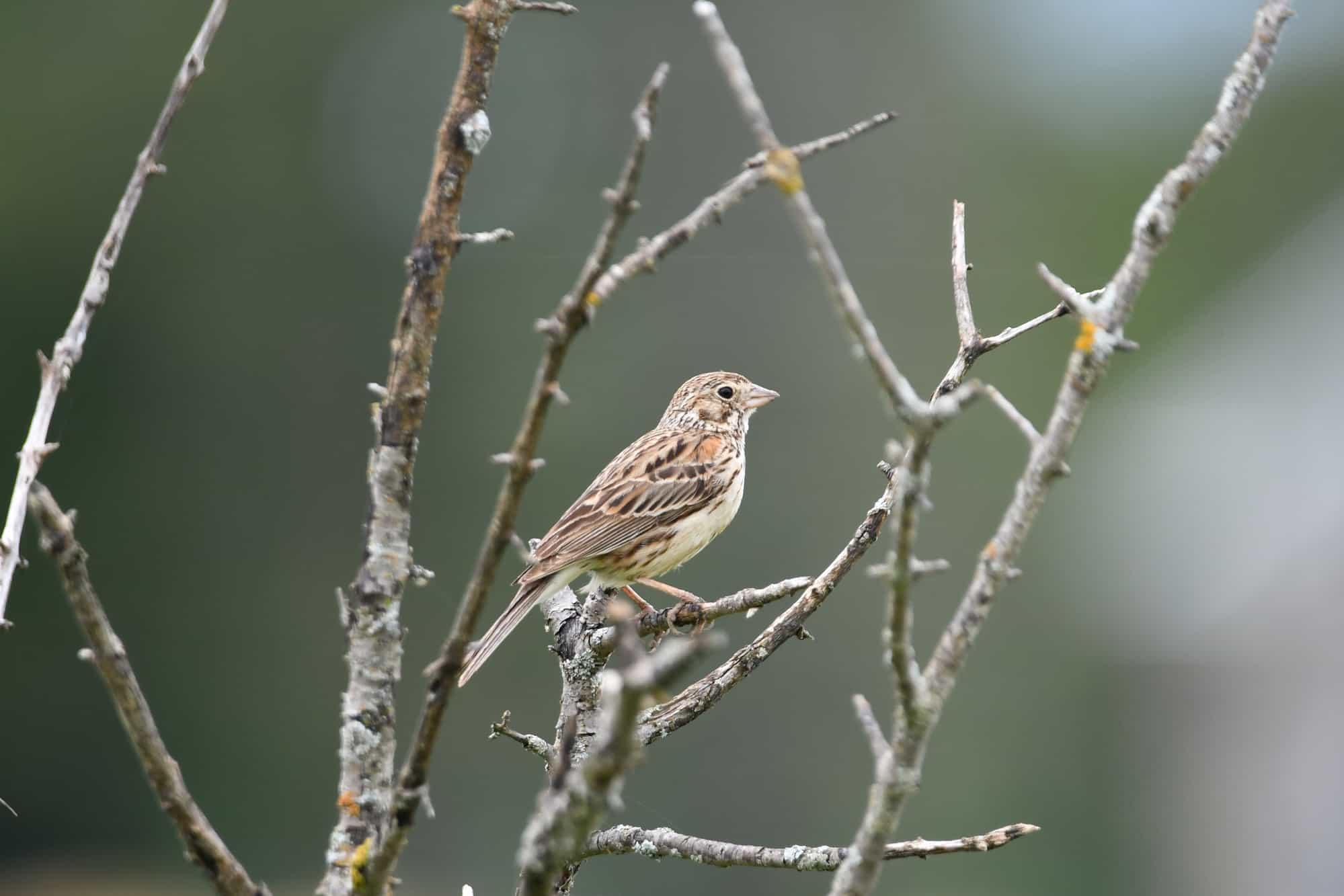
- Pooecetes gramineus
- ORDER: Passeriformes
- FAMILY: Passerellidae
- Length: 5.1-6.3 in (13-16 cm)
- Weight: 0.7-1.0 oz (20-28 g)
- Wingspan: 9.4 in (24 cm)
The large Vesper Sparrow has noticeable white eyerings, chestnut-brown shoulder patches, and a brown, streaky body.
The name “Vesper” comes from the evening prayer service that some Christian traditions hold at sundown. That’s because Vesper Sparrows sing their lovely, melodic song as the sun is setting.
They are summertime residents of Nebraska, nesting in tall grasses throughout the state. You are likely to find their nests beside a stump, log, or branch that has fallen onto the ground. This offers them protection from the elements and predators and helps them to stay hidden.
Winter-Only Sparrows of Nebraska
Nebraska has a handful of sparrows that only visit the state for the winter. These are the American Tree Sparrow, the Dark-Eyed Junco, the Harris’s Sparrow, and the Song Sparrow.
American Tree Sparrow
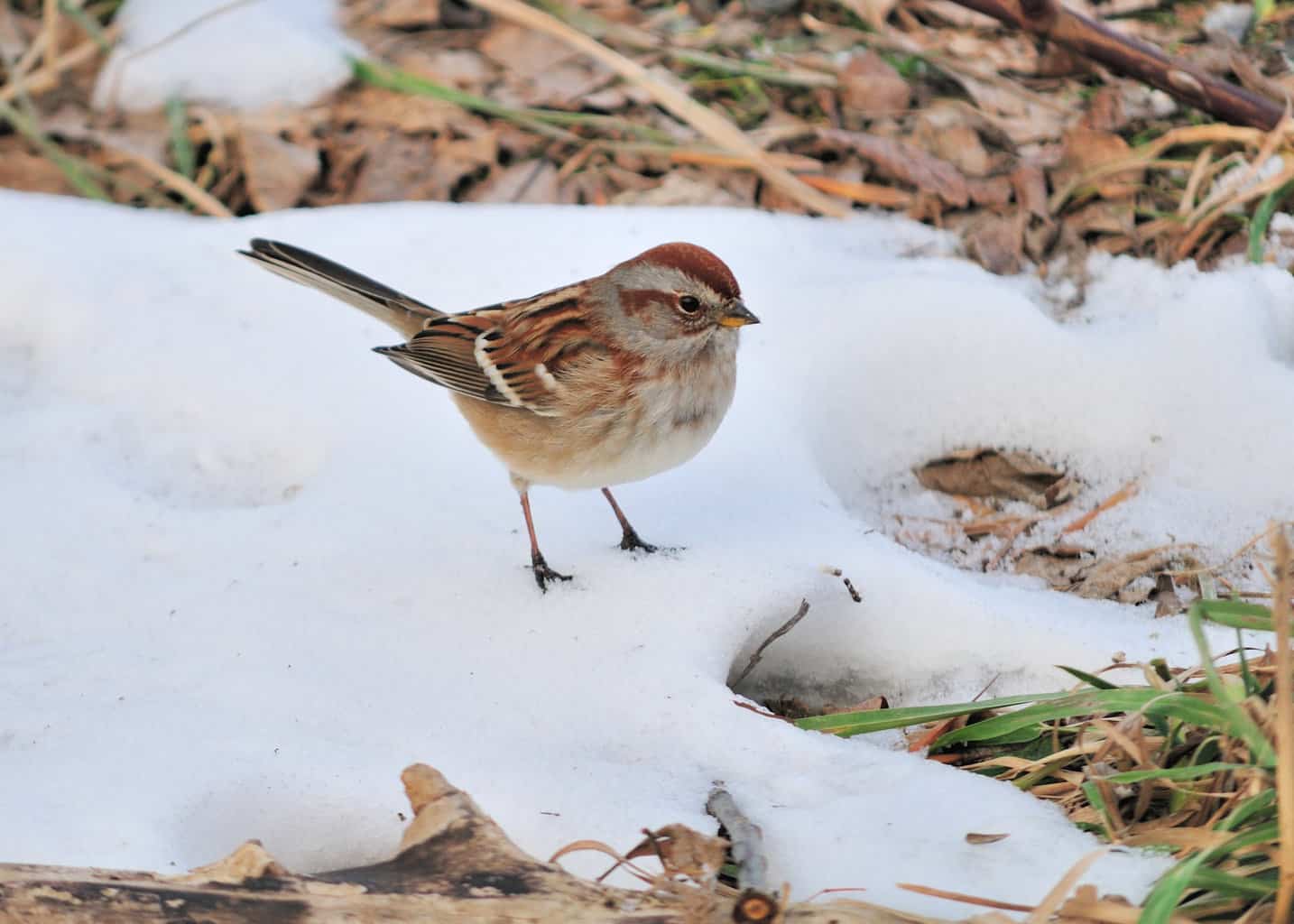
- Spizelloides arborea
- ORDER: Passeriformes
- FAMILY: Passerellidae
- Length: 5.5 in (14 cm)
- Weight: 0.5-1.0 oz (13-28 g)
- Wingspan: 9.4 in (24 cm)
Although some American Tree Sparrows have a noticeable red patch on their breast, you can’t really depend on that for identifying them, as not all individuals have this mark. They have gray bodies, dark red crowns, and striped wings.
American Tree Sparrows are widespread across Canada and much of the US. Their breeding territory in Canada includes the frigid tundra. Then, when it is time to migrate, they make their way throughout the US – except for the far southern states and the Pacific Coast.
In the winter, Nebraska’s American Tree Sparrows line the snowy fields and search for food. Every day, they have to eat 30% of their own body weight in food. You can find them in shrubby thickets and thick bushes.
Dark-Eyed Junco
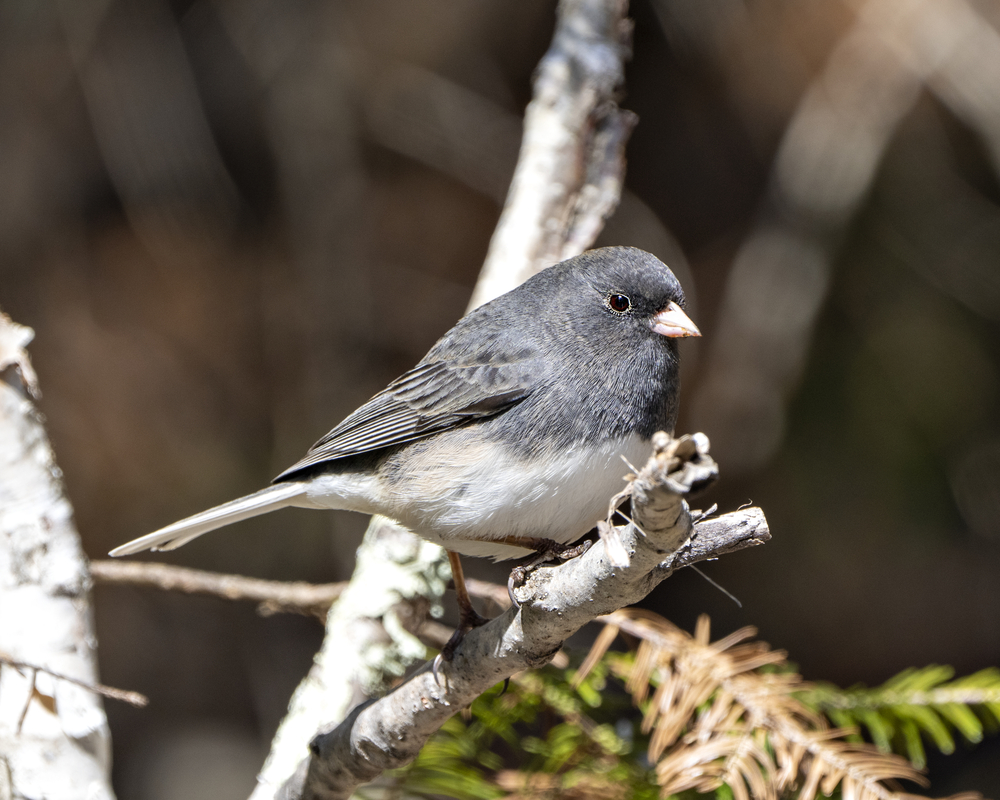
- Junco hyemalis
- ORDER: Passeriformes
- FAMILY: Passerellidae
- Length: 5.5-6.3 in (14-16 cm)
- Weight: 0.6-1.1 oz (18-30 g)
- Wingspan: 7.1-9.8 in (18-25 cm)
Dark-Eyed Juncos are common winter residents of Nebraska. They are widespread across the state. Because they are strongly associated with the arrival of winter, Dark-Eyed Juncos are sometimes called “snowbirds.”
They are dark little birds and easier to identify than several of the sparrows on this list. That’s because they are bi-colored: dark on top and light on the bottom. They also have pink bills and white outer tail feathers.
Their winter habitat includes woodlands, parks, fields, and roadsides. They are especially prevalent at backyard feeders. If you put out birdseed in the winter in Nebraska, you are likely to attract some Dark-Eyed Juncos.
Harris’s Sparrow
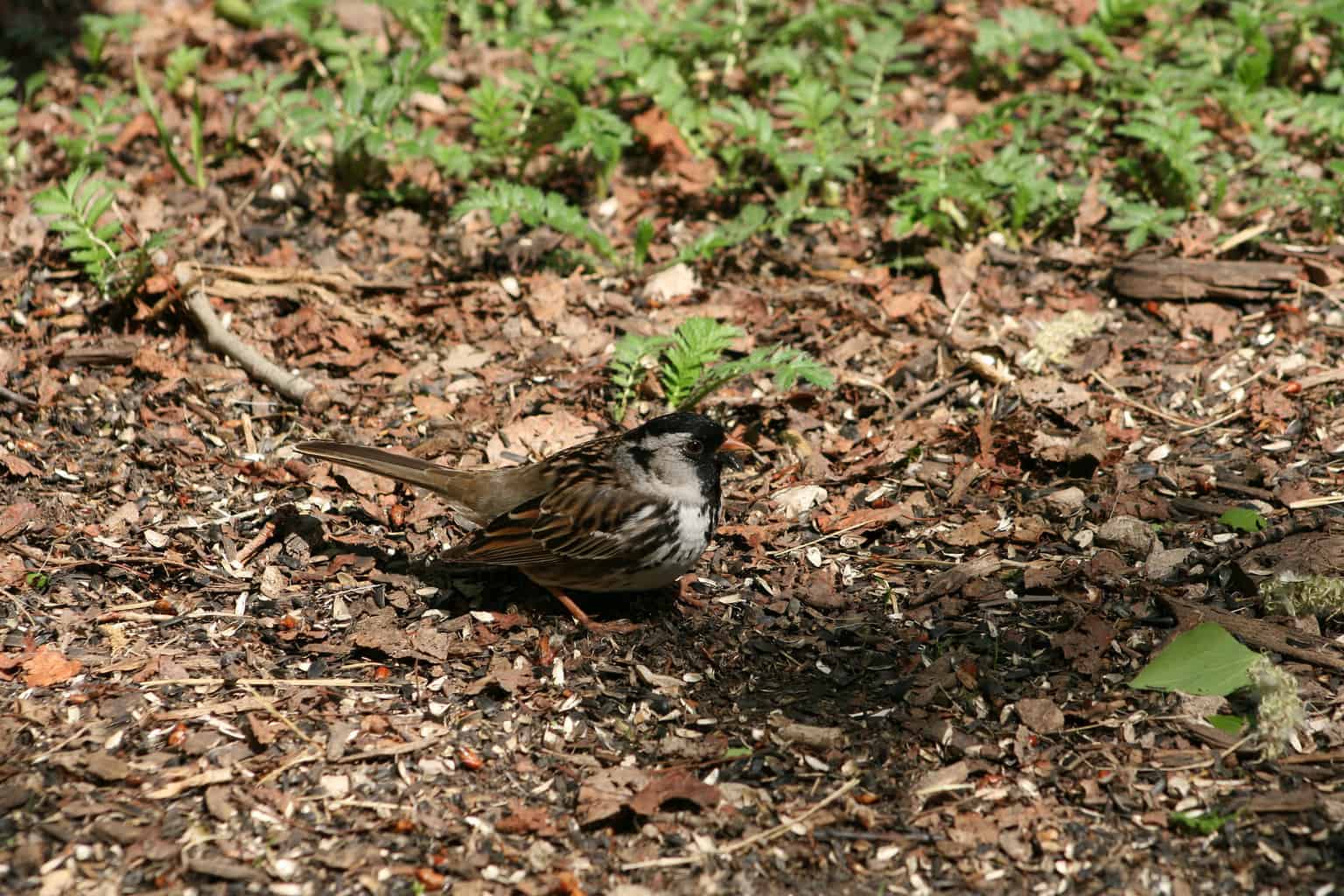
- Zonotrichia querula
- ORDER: Passeriformes
- FAMILY: Passerellidae
- Length: 6.7-7.9 in (17-20 cm)
- Weight: 0.9-1.7 oz (26-49 g)
- Wingspan: 10.6 in (27 cm)
To spot a Harris’s Sparrow, look for the distinctive black coloring on its face. It also stretches up to their crown and down their bib.
Juvenile male Harris’s Sparrows are patchier, but this bib/face/crown area becomes dark black in adulthood. In the summer, they have a gray nape and gray cheeks. In the winter, these areas are brown.
Harris’s Sparrows have pink bills, white bellies, and black streaks on their backs.
Interestingly, they are the only songbird that breeds exclusively in Canada. They migrate through the northern states and spend the winter in the Great Plains region. Specifically, they spend the winter in Nebraska, Kansas, and Oklahoma.
They are strictly migratory in the northwest of Nebraska, but they winter throughout the rest of the state.
Although Towhees are bigger, Harris’s Sparrows are among the largest sparrows in the United States.
Song Sparrow

- Melospiza melodia
- ORDER: Passeriformes
- FAMILY: Passerellidae
- Length: 4.7-6.7 in (12-17 cm)
- Weight: 0.4-1.9 oz (12-53 g)
- Wingspan: 7.1-9.4 in (18-24 cm)
Although Song Sparrows have a lot of regional variation in their appearance, there are some consistencies: they are brown and streaked with white on their chests. Their flanks are thick and white. Their coloring can be light or dark, and the amount of streaking varies.
Song Sparrows will consistently return to the previous year’s nesting grounds – or even to their previous nests. When they abandon a nest, a new Song Sparrow will likely move right in.
In Nebraska, Song Sparrows are widespread winter residents. On the eastern border of the state, some Song Sparrows stick around all year.
Their summer diet includes a lot of insects, but in the winter, they mostly eat seeds. You can easily attract Song Sparrows to your backyard by offering a feeder with plenty of seeds. Additionally, they are found throughout the winter in fields and thickets.
Migratory Sparrow Visitors to Nebraska
Some sparrows don’t stick around for summer or winter, but they stop in Nebraska as they are traveling along their migration routes. These birds may be in the state for a few days or a few weeks, but they are never here for an entire season.
These sparrows are the Brewer’s Sparrow, the Clay-Colored Sparrow, the Fox Sparrow, the LeConte’s Sparrow, the Lincoln’s Sparrow, the Nelson’s Sparrow, the Savannah Sparrow, the Swamp Sparrow, the White-Crowned Sparrow, and the White-Tailed Sparrow.
Brewer’s Sparrow
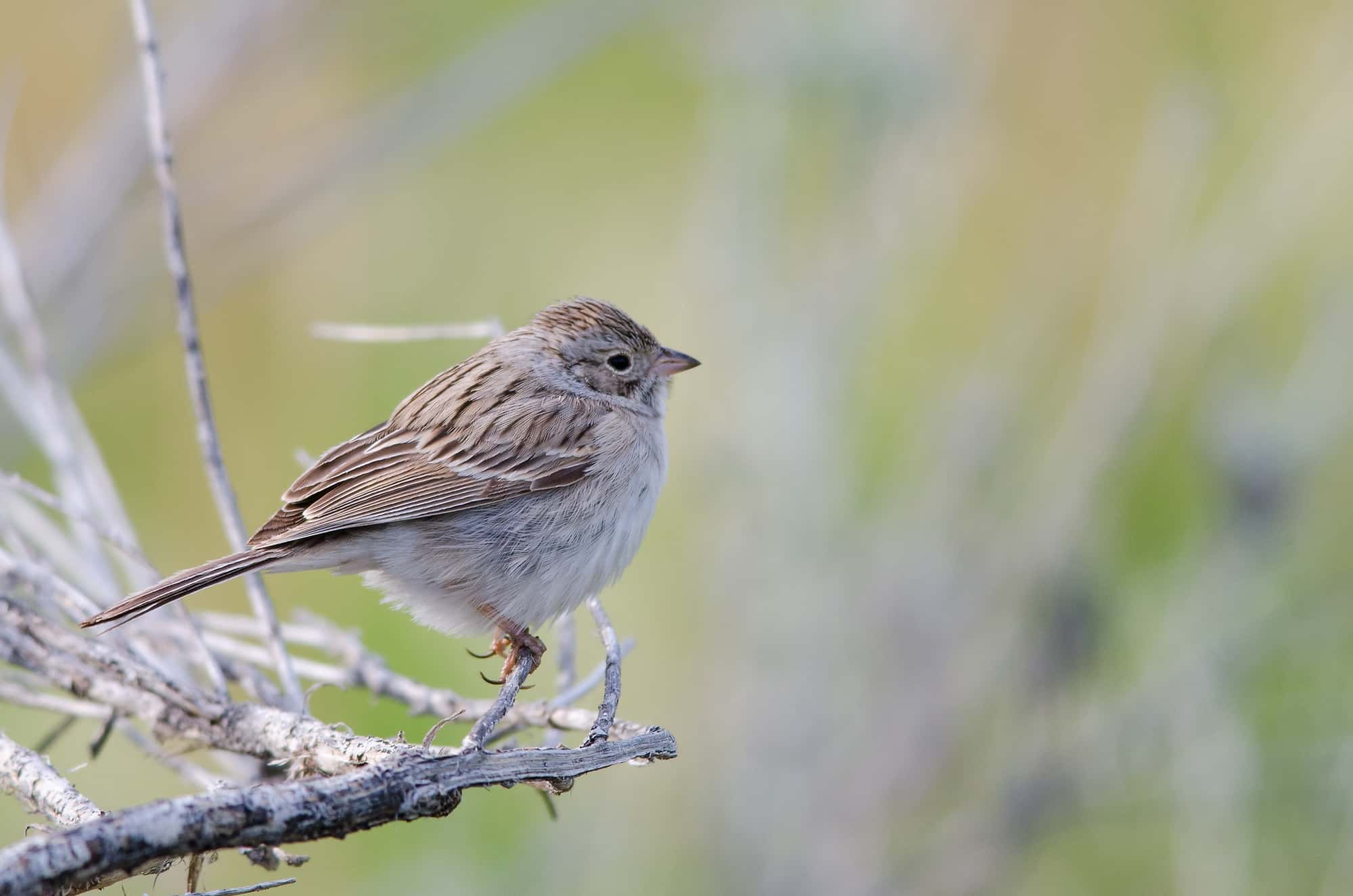
- Spizella breweri
- ORDER: Passeriform
- FAMILY: Passerellidae
- Length: 5.1-5.9 in (13-15 cm)
- Weight: 0.4-0.5 oz (11-14 g)
- Wingspan: 7.1-7.9 in (18-20 cm)
Brewer’s Sparrows are the smallest sparrows in North America. They are grayish-brown in color with dark and light brown stripes on their back.
Although they are somewhat plain in appearance, you can identify them by their white eyerings and the gray stripe above their eyes. They also have a notched tail and rounded wings.
In the summertime, Brewer’s Sparrows are widespread throughout the interior West. Some breed in the Nebraska panhandle, but for the most part, they are only migratory visitors in the state.
Clay-Colored Sparrow
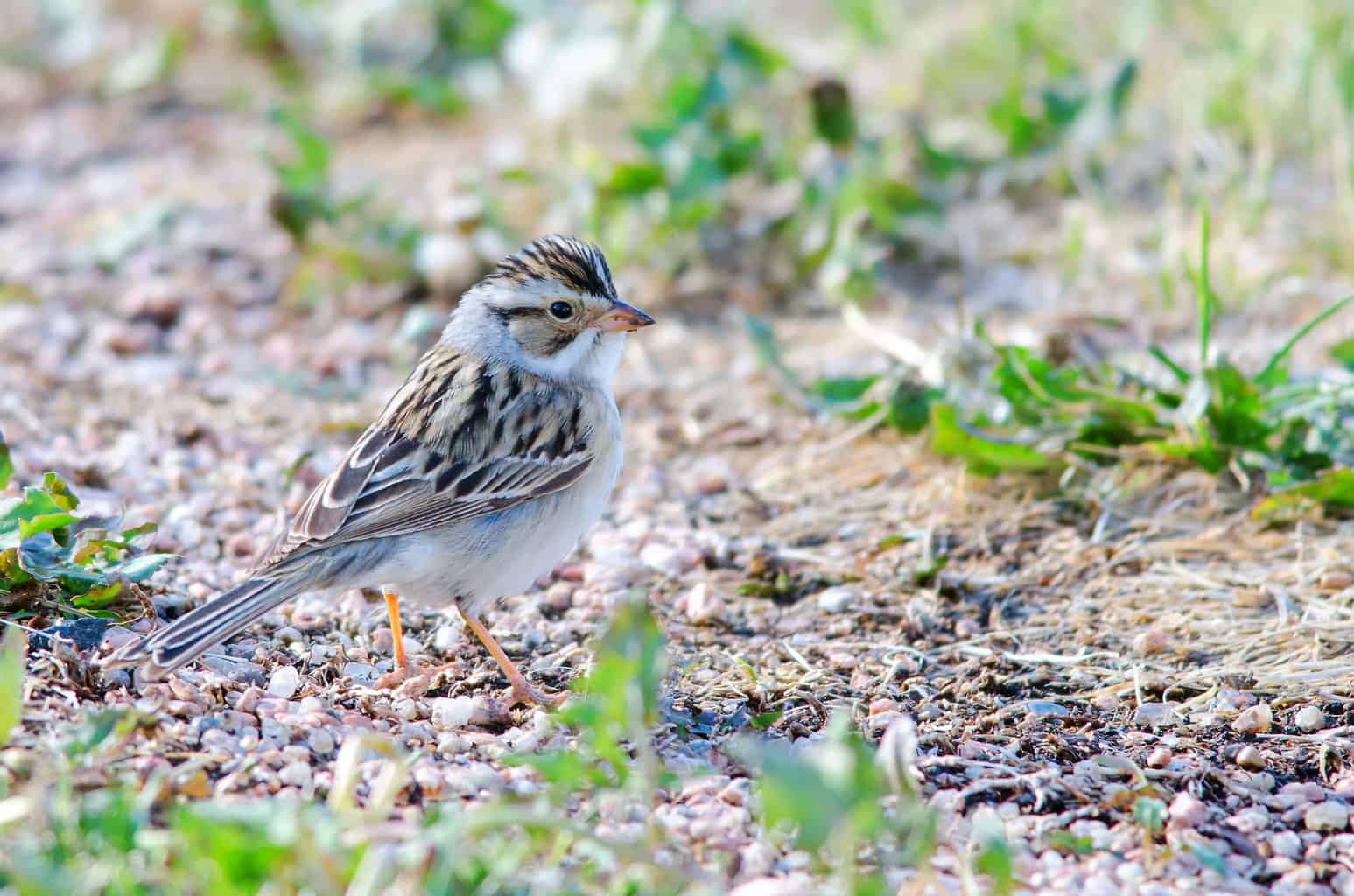
- Spizella pallida
- ORDER: Passeriformes
- FAMILY: Passerellidae
- Length: 5.1–6 in (130–150 mm)
- Weight: 12 g (0.42 oz)
- Wingspan: 7.5 in (190 mm)
Clay-Colored Sparrows have a grayish-tan appearance, like clay. They also have a pale gray collar around the neck and thin, fine streaking on their head.
They live exclusively in central North America with a range that extends from northern Canada to southern Mexico. They migrate through Nebraska every year as they move between these two territories.
Listen and watch for them in thickets along the edges of fields.
Clay-Colored Sparrows have declining numbers, but they are still the most common songbirds in the US’s northern prairies.
Fox Sparrow

- Passerella iliaca
- ORDER: Passeriformes
- FAMILY: Passerellidae
- Length: 5.9-7.5 in (15-19 cm)
- Weight: 0.9-1.6 oz (26-44 g)
- Wingspan: 10.5-11.4 in (26.7-29 cm)
Learning to identify a Fox Sparrow can be a little tricky, as their patterns can vary quite a lot from one bird to the next. They have gray bodies and reddish-brown streaking, but the amount of streaking varies significantly.
Sometimes, Fox Sparrows will look almost entirely red. Other times, they are mostly gray with some red stripes on their backs and wings.
They also have dark brown chest spots.
Fox Sparrows are messy little birds. They kick up a lot of litter as they are looking for insects and seeds on the ground. If you see leaves and dirt flying about under your birdfeeder, don’t be surprised if it’s a Fox Sparrow!
LeConte’s Sparrow
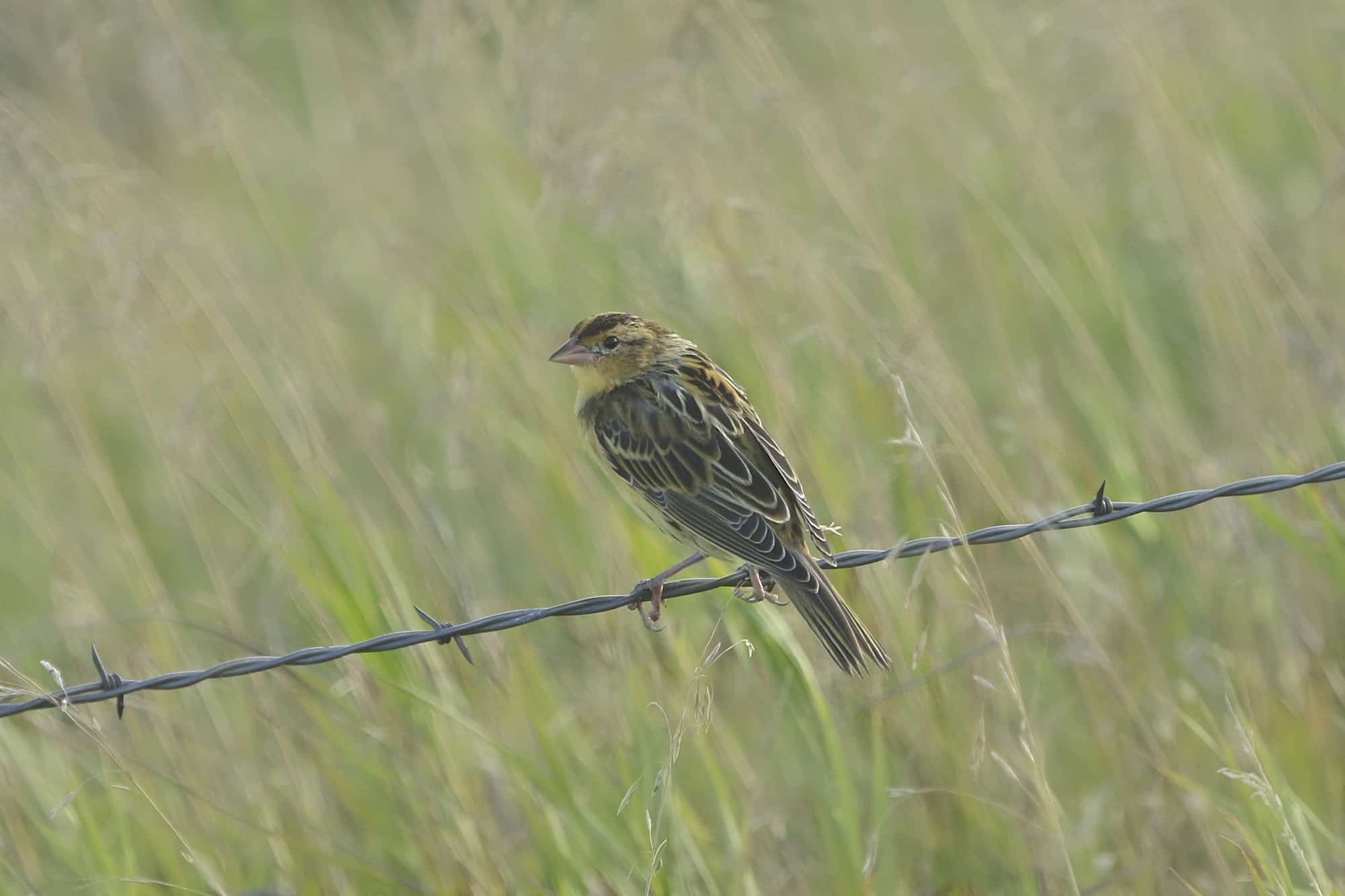
- Ammospiza leconteii
- ORDER: Passeriformes
- FAMILY: Passerellidae
- Length: 4.7-5.1 in (12-13 cm)
- Weight: 0.4-0.6 oz (12-16.3 g)
- Wingspan: 6.3-7.1 in (16-18 cm)
LeConte’s Sparrows are well known for their ability to hide. They breed in remote areas and avoid people altogether. They rarely leave the cover of the thick brush where they live. Some naturalists describe their behavior as mouse-like, as they tend to scurry away from danger instead of flying.
They have thick, round bodies and flat heads. Their wings are very short, and their coloring is pale with an orangeish hue. The orange coloring is especially noticeable on the head and breast. They have black-streaked wings and backs and a grayish-purple patch on the back of their neck.
Because they are declining in number so consistently for the past several decades, they have been added to the Yellow Watch List.
They migrate through the eastern half of Nebraska.
Lincoln’s Sparrow
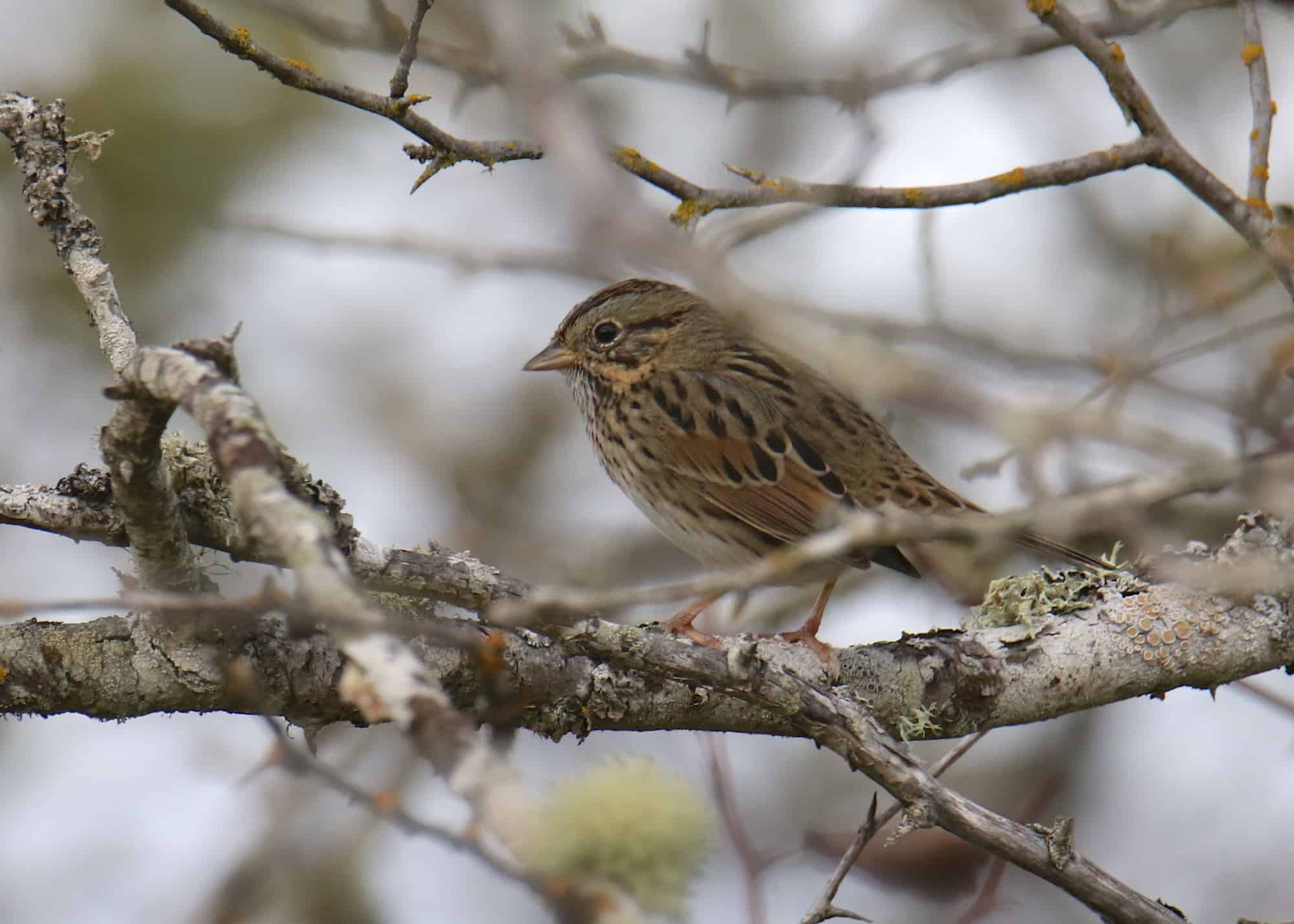
- Melospiza lincolnii
- ORDER: Passeriformes
- FAMILY: Passerellidae
- Length: 5.1-5.9 in (13-15 cm)
- Weight: 0.6-0.7 oz (17-19 g)
- Wingspan: 7.5-8.7 in (19-22 cm)
Lincoln’s Sparrows are mostly gray, and they have a gray stripe down the middle of the crown, plus a pale mustache. Additionally, they have white bellies, rusty-brown tips on their tails and wings, and dark brown stripes.
They migrate through Nebraska in the fall and spring. You can expect to see them moving through the state between March and May. Then, they will migrate again starting in September.
When they migrate, they usually hide in thickets along Nebraska’s roadside and forest edge thickets.
Nelson’s Sparrow
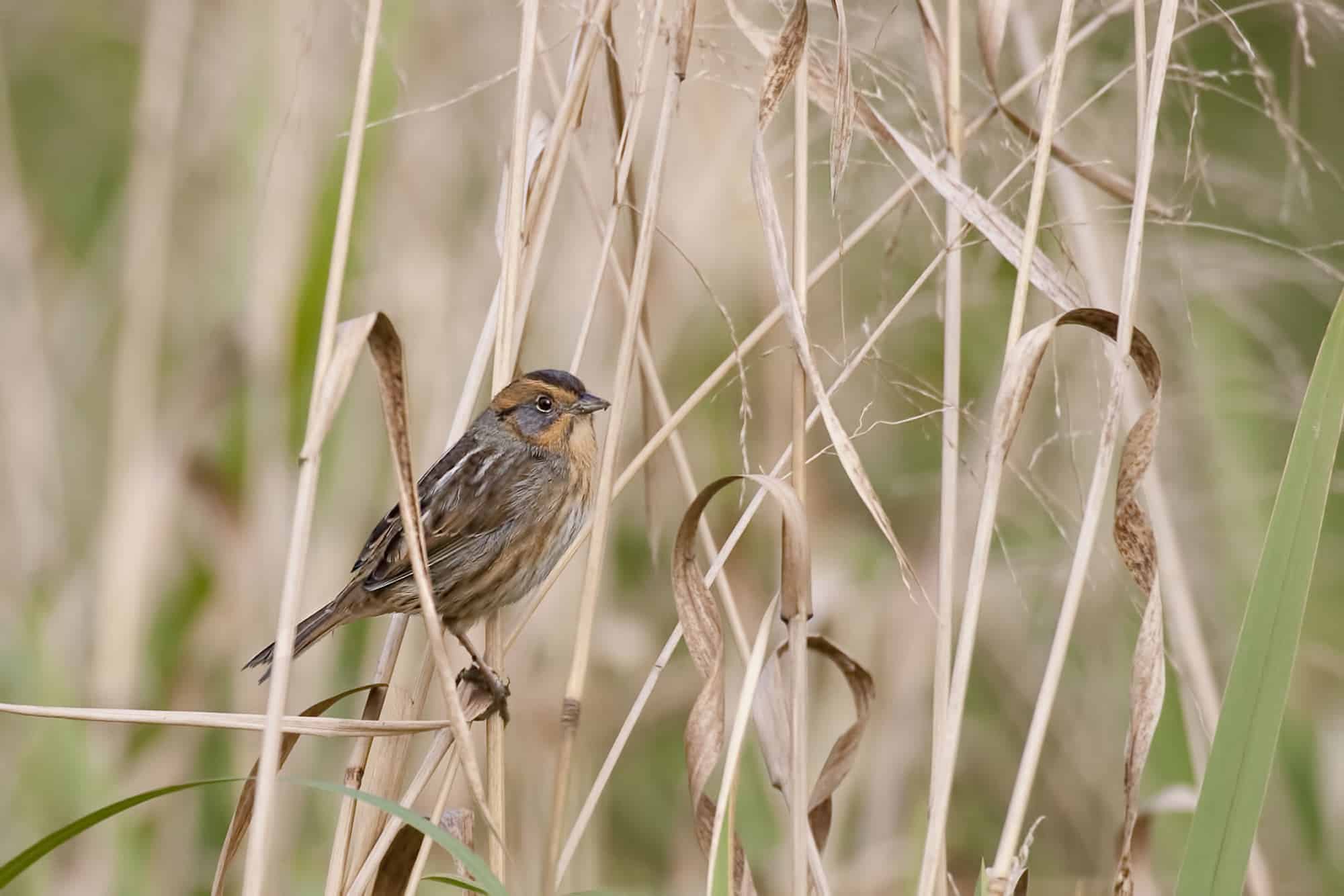
- Ammospiza nelsoni
- ORDER: Passeriformes
- FAMILY: Passerellidae
- Length: 4.3-5.1 in (11-13 cm)
- Weight: 0.6-0.7 oz (17-21 g)
- Wingspan: 6.5-7.9 in (16.5-20 cm)
Nelson’s Sparrows are yellow and brown. The ones that breed on the Hudson Bay and Gulf of St. Lawrence tend to be lighter in color, whereas the ones that breed in Alberta and Saskatchewan are darker.
When you see a Nelson’s Sparrow migrating through Nebraska, it is one of those darker varieties from Canada.
Until recently, Nelson’s Sparrows and Saltmarsh Sparrows were thought to be one species: the Sharp-Tailed Sparrow. However, they were differentiated from one another in 2009. Nelson’s Sparrows were given their name in honor of Edward William Nelson, an American naturalist.
Savannah Sparrow
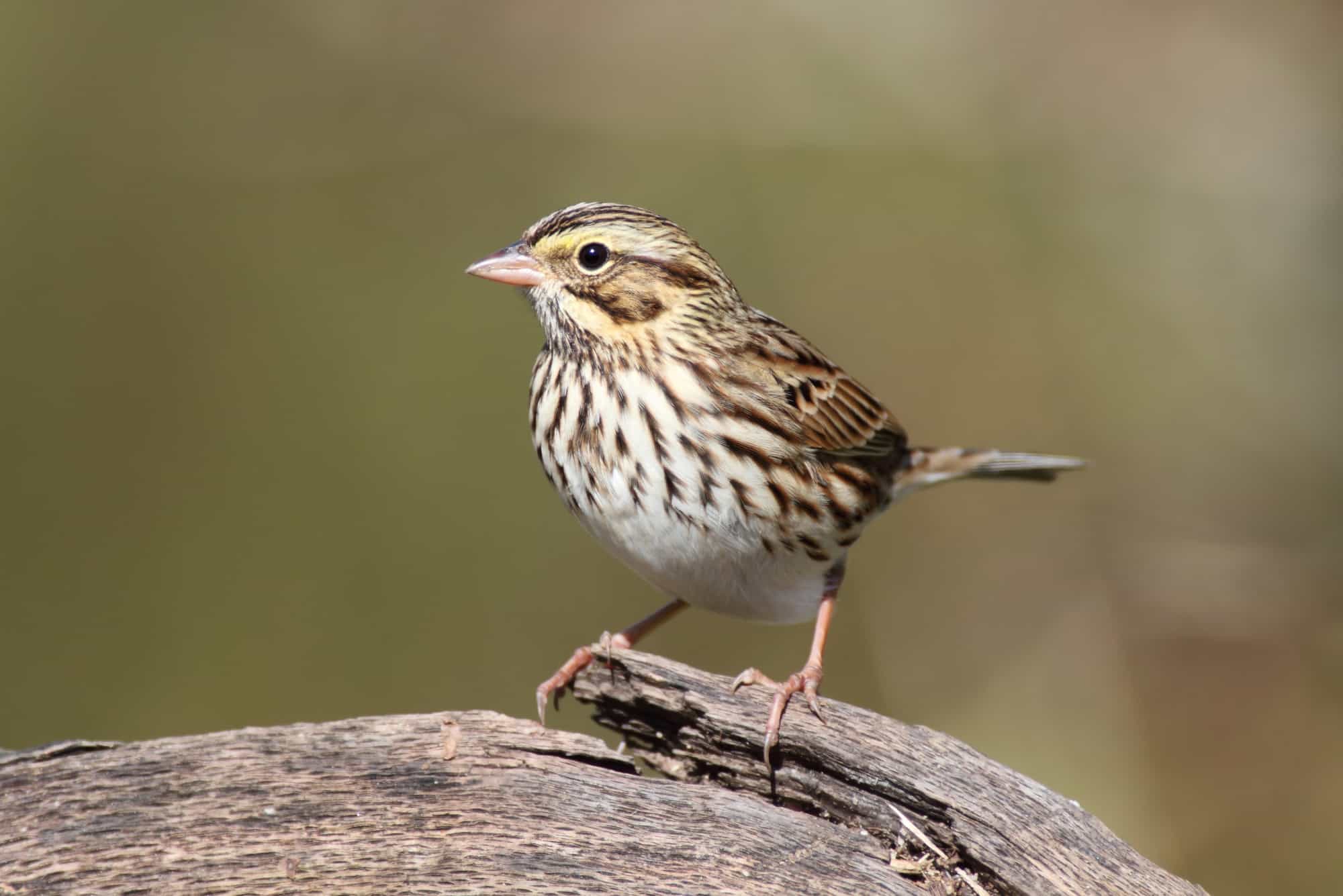
- Passerculus sandwichensis
- ORDER: Passeriformes
- FAMILY: Passerellidae
- Length: 4.3-5.9 in (11-15 cm)
- Weight: 0.5-1.0 oz (15-28 g)
- Wingspan: 7.9-8.7 in (20-22 cm)
Savannah Sparrows have a yellow area between their eyes and the bill. That makes it pretty easy to spot them, even if they are with other sparrows. Savannah Sparrows are very social, so you will often encounter them in large groups.
They migrate through Nebraska every year, with some populations breeding in the Nebraska panhandle.
Look for their small heads, the dark streaks on their wings and backs, and their sharp little bill.
In the panhandle, they will usually nest in tall dead grass from the previous season, but you may also find them in shrubby bushes like blueberries, goldenrod, blackberries, bayberries, and other patchy plants.
Swamp Sparrow
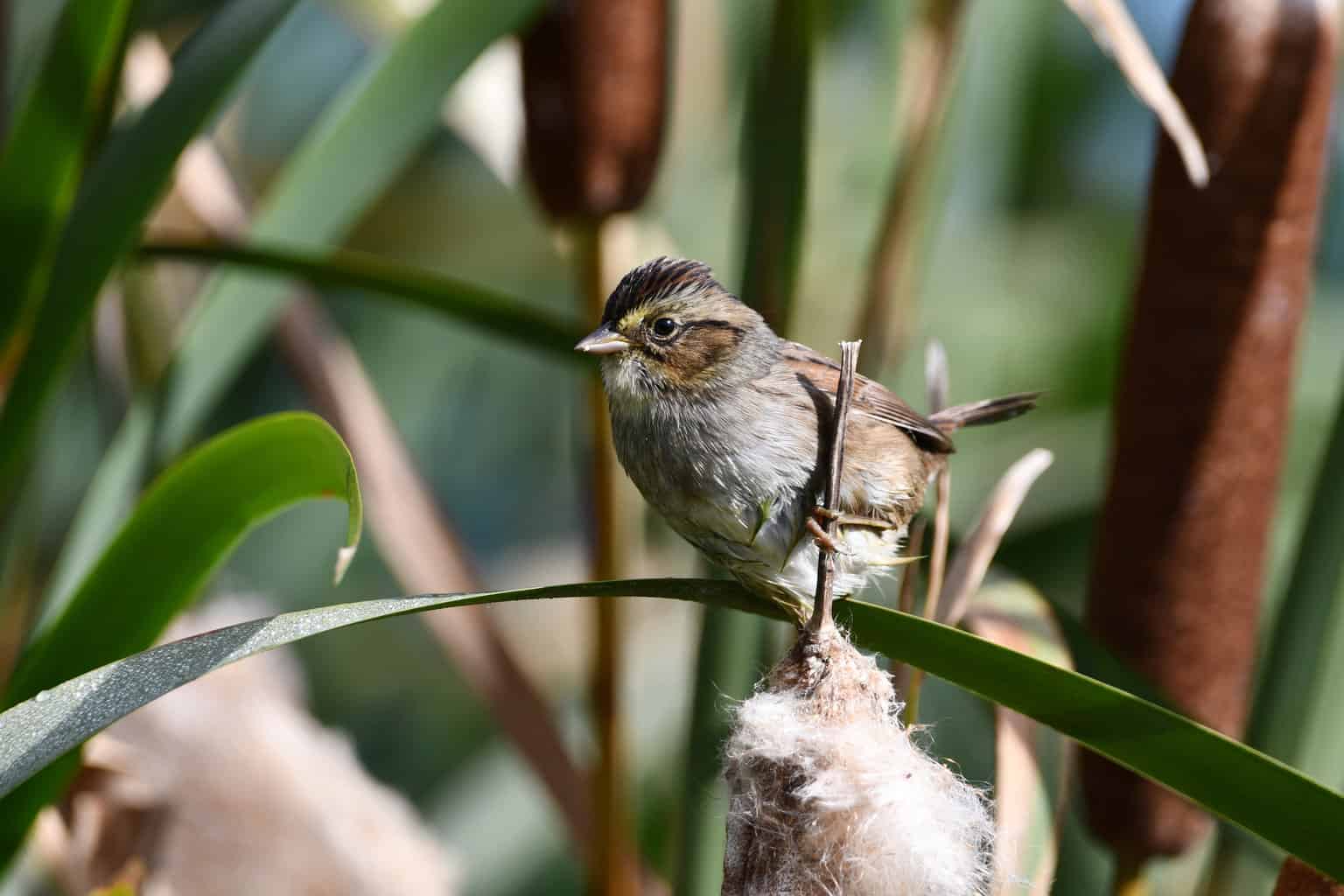
- Melospiza georgiana
- ORDER: Passeriformes
- FAMILY: Passerellidae
- Length: 4.7-5.9 in (12-15 cm)
- Weight: 0.5-0.8 oz (15-23 g)
- Wingspan: 7.1-7.5 in (18-19 cm)
Swamp Sparrows sometimes get mixed up with Song Sparrows or Chipping Sparrows.
Swamp Sparrows are round with long tails like the Song Sparrow, but they have reddish-brown coloring on their wings and a reddish-brown cap for differentiation.
Because Chipping Sparrows also have a red cap, there is room for confusion there, too. But Swamp Sparrows are larger than Chipping Sparrows, and they are less vocal.
The Swamp Sparrow’s long, strong legs also help to give away its identity. It uses those strong legs to forage through the mud for food.
Swamp Sparrows are mostly migratory visitors in Nebraska, although the northeast corner of the state is on the very edge of their breeding territory. You could potentially see Swamp Sparrows near South Sioux City and Wayne.
White-Crowned Sparrow
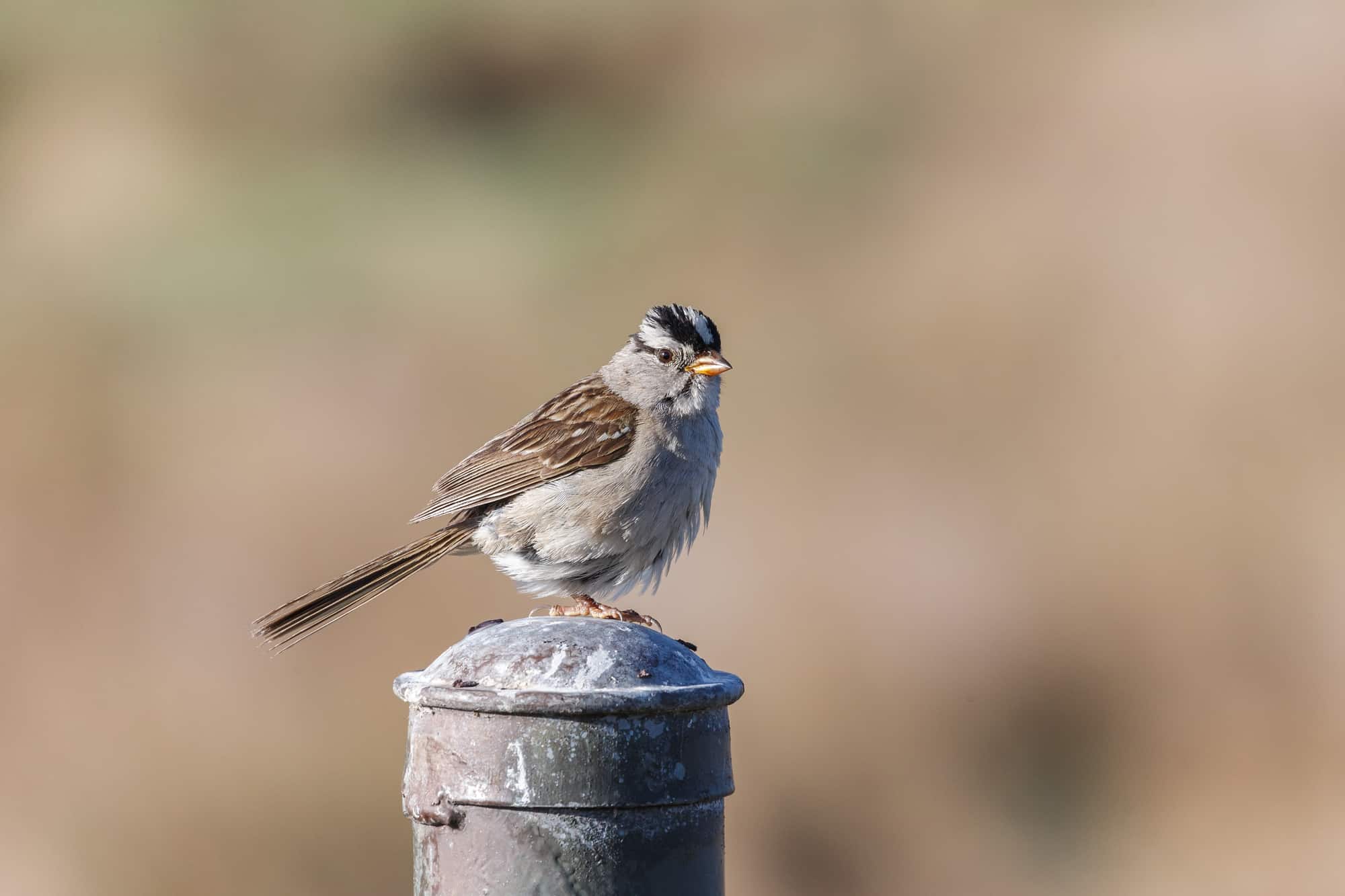
- Zonotrichia leucophrys
- ORDER: Passeriformes
- FAMILY: Passerellidae
- Length: 5.9-6.3 in (15-16 cm)
- Weight: 0.9-1.0 oz (25-28 g)
- Wingspan: 8.3-9.4 in (21-24 cm)
The mostly drab brown coloring of the White-Crowned Sparrow contrasts with its black and white striped head. Its crown can be raised and lowered just a bit. It has a rounded shape and a pink, yellow, or light orange bill.
The White-Crowned Sparrow is a migratory visitor to central Nebraska. In the east, west, and south, they are likely to stick around all winter.
Both in migration and during the winter, they spend their time in thickets and weedy fields, as well as on roadsides and in backyards. If you live in the White-Crowned Sparrow’s winter territory, you can easily attract these cute little birds to your yard with a feeder.
White-Throated Sparrow
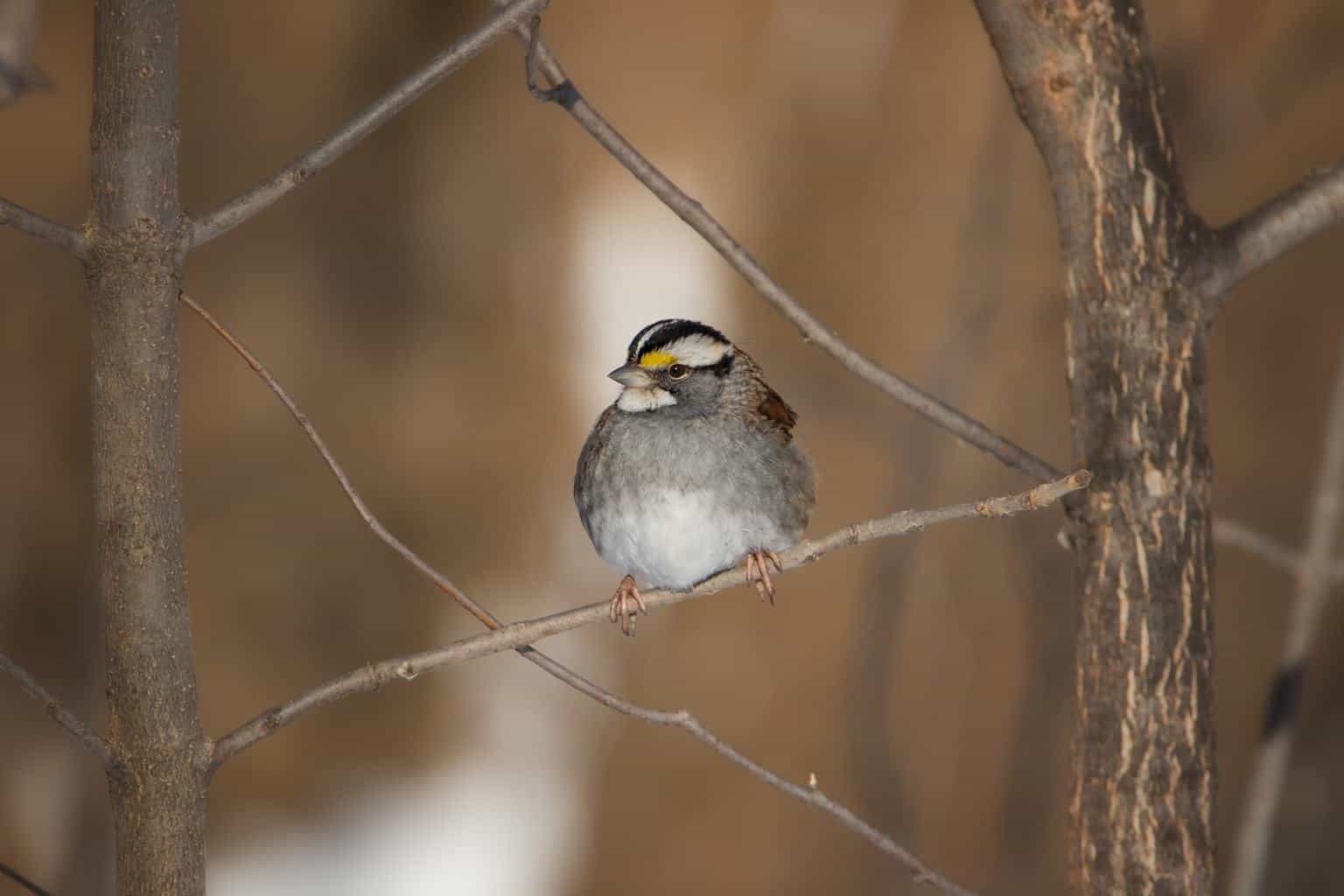
- Zonotrichia albicollis
- ORDER: Passeriformes
- FAMILY: Passerellidae
- Length: 6.3-7.1 in (16-18 cm)
- Weight: 0.8-1.1 oz (22-32 g)
- Wingspan: 7.9-9.1 in (20-23 cm)
White-Throated Sparrows have a distinct white throat, as their name suggests. The rest of the White-Throated Sparrow’s body is dark gray, and it has black stripes across the head and eyes.
They have colorful lores – the space between the eyes and the bill. On a White-Throated Sparrow, this area is bright yellow.
They are migratory visitors throughout all of Nebraska.
Finding Sparrows in Nebraska
If you’re looking for sparrows in Nebraska, you’re in luck. These little brown jobs are everywhere!
Whether you live in the state or are just visiting, there are plenty of sparrows to find and identify. Give yourself the challenge of learning to recognize the 25 different types of sparrows – and have fun!

